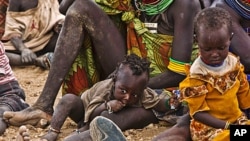The World Food Program says it is speeding up aid deliveries to the Horn of Africa, where more than 12 million people need urgent help to deal with famine and drought.
The group said Tuesday it is starting the first of nine airlifts to Mombasa, Kenya, with enough high-energy biscuits to feed 1.6 million people for a day. From there, the provisions will be sent to vulnerable people across the region.
|
Definition of Famine: The word famine is a term that is not used lightly by humanitarian organizations. The United Nations describes a crisis as a famine only when the following conditions are met:
Current Famine:
|
The WFP says it plans to send thousands of tons of fortified foods to Somalia during the next two months, particularly to help malnourished children under the age of 5.
Meanwhile, the U.N. Food and Agriculture Organization (FAO) says it is very concerned about the large numbers of Somalis leaving their homes in search of food and water.
The agency says the Somalis are flooding refugee camps and leaving behind farms without planting new crops.
An official says the FAO is working on ways to keep people at home. The agency also called a high-level meeting on the drought crisis for August 18.
Aid delivery
In the capital, Mogadishu on Tuesday, aid groups continued to deliver food and other supplies to drought and famine victims, after the withdrawal of al-Shabab militants on Saturday.
The U.N. refugee agency airlifted more than 31-metric tons of aid to the capital on Monday, completing its first relief flight into the capital in more than five years.
Al-Shabab controlled parts of Mogadishu until the pullout. The group has has banned most foreign aid groups from operating in areas under its control, including most of the five areas declared famine zones by the United Nations.
The United Nations estimates that 3.7 million people in Somalia are in need of aid, with more than two million of them living in the south.
Slideshow: Somalia Famine












